MusicRadar Verdict
A fingerstyle-friendly belter: yet more proof that small is the new big! Track one down and try it out.
Pros
- +
Great tones both plugged and unplugged. Solid, neat build quality. Good value.
Cons
- -
High string grooves.
MusicRadar's got your back
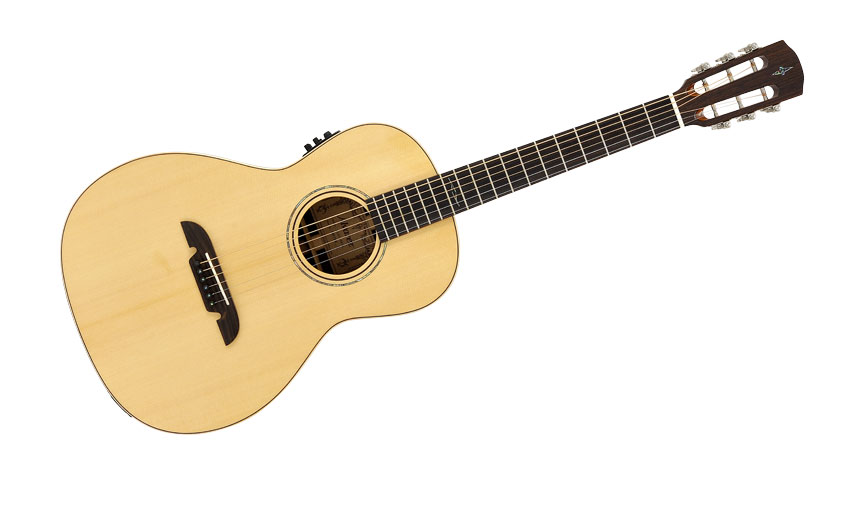
Alvarez MP70E
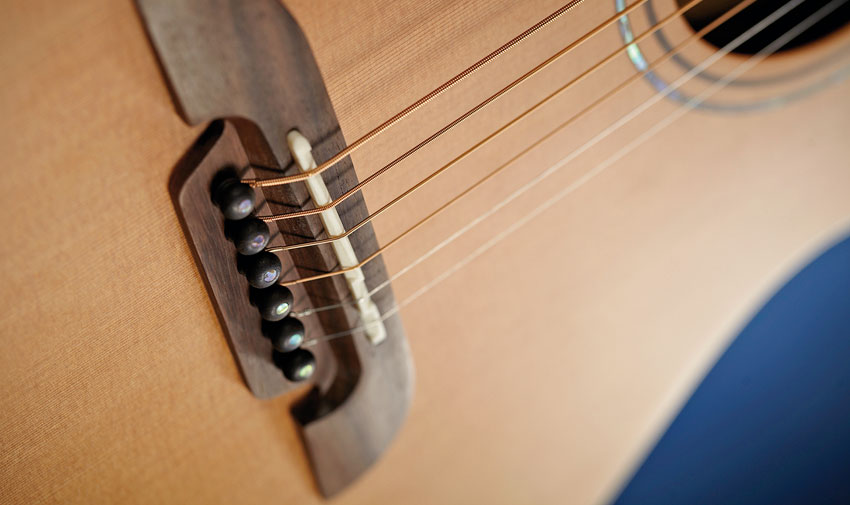
Bridge
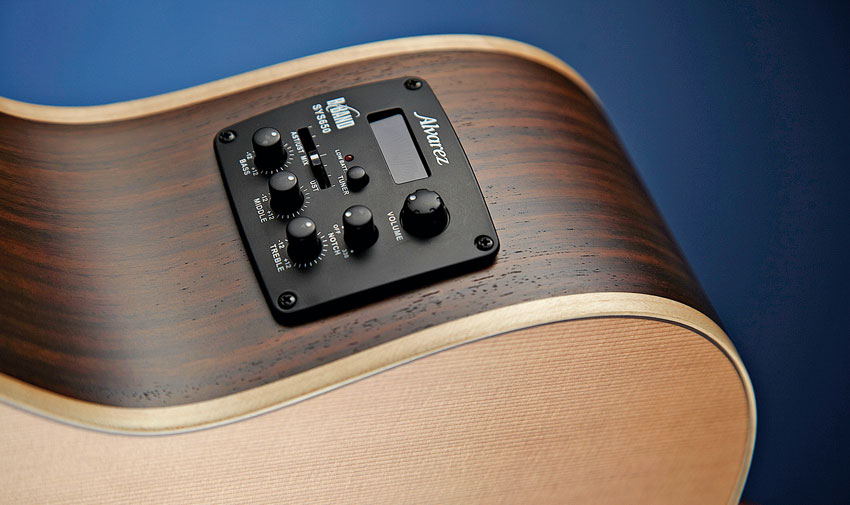
Preamp
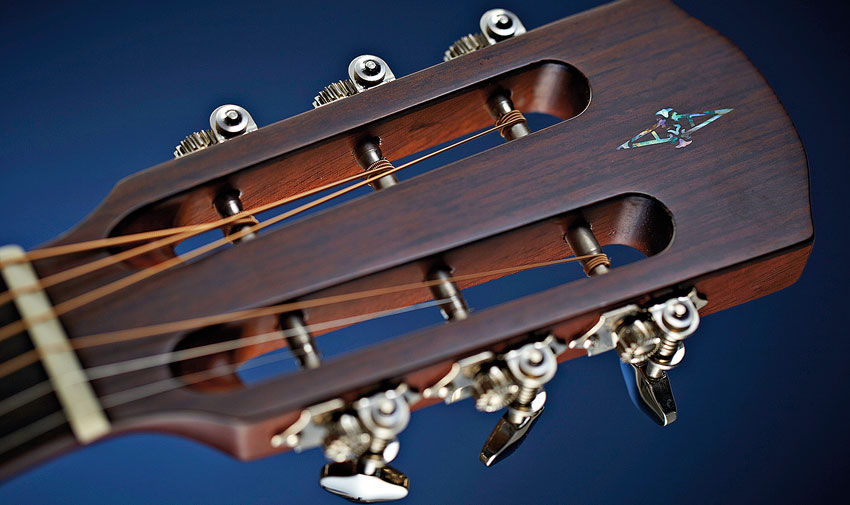
Headstock
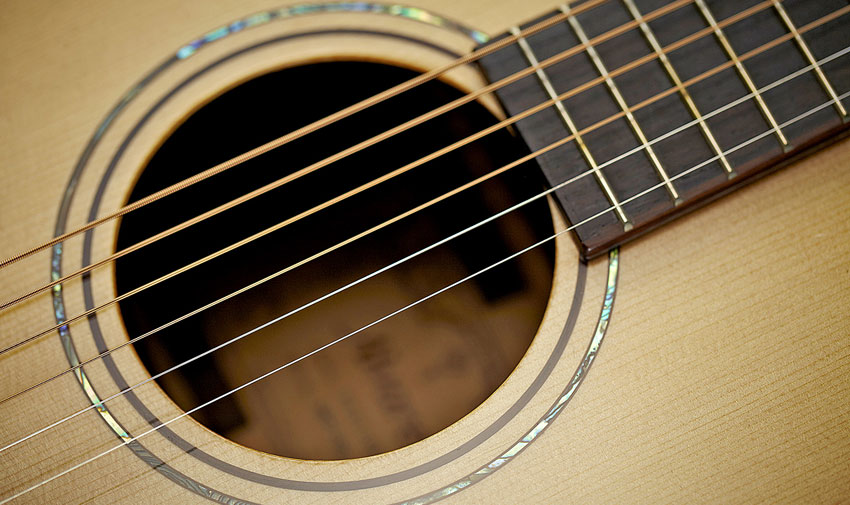
Soundhole
Alvarez's Chinese-built range of electro acoustics are temptingly priced, with prices starting at under £200 and stretching up to the Masterworks models (priced £559 to £899). The MP70E is a parlour acoustic and is priced close to that top figure.
Build
The modern parlour guitar is a bit of a catch-all term that refers usually to a small body, quite often with 12-frets clear of the body. Size-wise, this is close to, say, a Martin 00, although the actually styling of this guitar, especially the low waist, takes us back more to Martin's earlier and smaller '2' outline.
Build quality is impressive, starting with the high-gloss finish, which avoids being over gloopy, especially on the all-important soundboard.
"The 'one-piece' mahogany neck construction refers to the fact that the headstock is from the same piece as the main neck"
The 'one-piece' mahogany neck construction refers to the fact that the headstock is from the same piece as the main neck, not laminated like so many lower-priced guitars; it's correctly quarter-sawn for maximum stiffness and attaches to the body with a traditional dovetail joint.
The flat dome heel is a separate piece - nothing wrong with that, of course, nor the chunky old-school depth to the D-shaped profile that might not seem as 'fast' to an electric player, but it gives a sense of purpose and is very comfortable in the hand.
Fretting is good, too; the fingerboard edges are actually bound with a separate strip of rosewood so you don't see any fret ends - very typical of modern Chinese craft. The string grooves in bone nut could be a little lower, but there's a fingerstyle-friendly, broader nut width - with a string spread of 38mm - and a slotted headstock with nicer, side-mounted Waverly-style, open-backed tuners.
A nicely compensated bone saddle sits atop the 'Bi Level' rosewood bridge with its abalone-dotted ebony pins, which sit in the lower central section. It creates a steep angle for the string behind the saddle and is quite possibly one of the reasons why our review guitar has a vibrant piano-like ring and sustain.
As a stage-intended electro, along with a second strap button, we get the so-called SYS650 preamp that controls a dual pickup system. Aside from the Alvarez logo, it's the standard OEM B-Band T65 made exclusively to be used on guitars like these.
While the majority of dual systems involve an under- saddle and an internal mic, here we have a thin UST (under-saddle transducer) and a larger AST (acoustic soundboard transducer) that sits directly under the bridge-plate.
Both transducers are made from Emfit ferro-electret film. With a slider mix control, volume, three-band EQ and a notch filer, along with an output-muting chromatic tuner with a clear LCD display, it's a very thorough system.
Battery access is on the side by the lower strap button, and we have both an unbalanced standard jack output along with balanced XLR.
Feel & Sounds
"It is simply ideal for lead lines, especially on bottleneck"
Being a parlour model, this acoustic is fairly narrow sounding with a trim, tight bass end, and punchy highs but a midrange that's full and forceful. It is simply ideal for lead lines, especially on bottleneck.
The electro performance is also well above average and the bass EQ certainly adds a full low depth, but with it comes immense feedback potential. The mid frequency is well aimed, and with some reduction here and a little lift of the treble EQ it's extremely easy to dial in that modern electro scooped zing.
The AST pickup on its own gives a paper-y edge and mic-like realism to the electro voice along with an increase in handling noise. The UST is more standard piezo-like with a more direct tone. If you crave a studio-like mic'd sound and can control it, the AST gives a very natural sound on its own, which is great for percussive styles, of course, because it's sensing much more of the top's vibration.
At higher volumes, though, it might be too much, and although it seems to have a far higher feedback threshold than most onboard mic systems, less is definitely recommended. The notch filter is pretty effective, although a phase control would be a handy addition: oddly, in the T65 user manual a phase switch is referred to, though not actually on the preamp.
In conclusion, this is a fine guitar for the money with one of the best electro systems we've come across. If you haven't checked it out already, then add Alvarez to your mid-priced electro 'must-try' list.
Dave Burrluck is one of the world’s most experienced guitar journalists, who started writing back in the '80s for International Musician and Recording World, co-founded The Guitar Magazine and has been the Gear Reviews Editor of Guitarist magazine for the past two decades. Along the way, Dave has been the sole author of The PRS Guitar Book and The Player's Guide to Guitar Maintenance as well as contributing to numerous other books on the electric guitar. Dave is an active gigging and recording musician and still finds time to make, repair and mod guitars, not least for Guitarist’s The Mod Squad.
“Delivers streamlined DAW integration with an excellent hammer action keyboard”: Arturia Keylab 88 Mk3 review
“I have an original 909 – every time I try to use it I feel like I’m ruining it”: House hero Riva Starr on his studio essentials and his love of analogue synths
“A synthesizer that is both easy to use and fun to play whilst maintaining a decent degree of programming depth and flexibility”: PWM Mantis review










